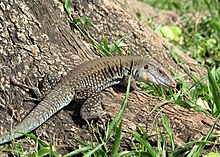Ameiva exsul
| Ameiva exsul | |
|---|---|
 |
|
| Scientific classification | |
| Kingdom: | Animalia |
| Phylum: | Chordata |
| Class: | Reptilia |
| Order: | Squamata |
| Family: | Teiidae |
| Genus: | Ameiva |
| Species: | A. exsul |
| Binomial name | |
|
Ameiva exsul Cope, 1862 |
|
| Synonyms | |
|
|
Ameiva exsul (English vernacular: Puerto Rican ground lizard or common Puerto Rican ameiva; Spanish vernacular: iguana) is a species of lizard in the whiptail family.
In addition to the nominotypical subspecies (Ameiva exsul exsul Cope, 1862) two other subspecies are recognized as being valid. Isla Mona has a smaller subspecies (Ameiva exsul alboguttata Boulenger, 1896), whereas Isla Desecheo has a larger subspecies (Ameiva exsul desechensis Heatwole & Torres, 1967).
Ameiva exsul is found in coastal habitats of Puerto Rico, the United States Virgin Islands, the British Virgin Islands, Isla Culebra, Isla Mona, Isla Desecheo, and most satellite islands. The species is also found in the Toro Negro State Forest.
Ameiva exsul is a relatively large lizard. The maximum recorded male snout-to-vent length (SVL) is 201 mm (7.9 in), and the maximum recorded female SVL is 99 mm (3.9 in). Color patterns vary widely among individuals, populations, and islands. Animals are predominantly colored gray, black, or brown, with large or small white dots along their backs. Dorsolateral stripes vary in number, length, and color. All individuals have a white or blue-white mottled stomach. The chin shield and throat patch are often light pink. Juveniles generally have a bright blue tail and more dots than stripes.
Puerto Rican ground lizards occur in habitat with open canopy structure and loose sandy soil in elevations between sea-level and 150 m (490 ft) where the temperature is above 24° C (75° F) year-round. Ground lizards forage for insects and small fruits and scavenge for dead animals or trash scraps in urban areas.
...
Wikipedia

